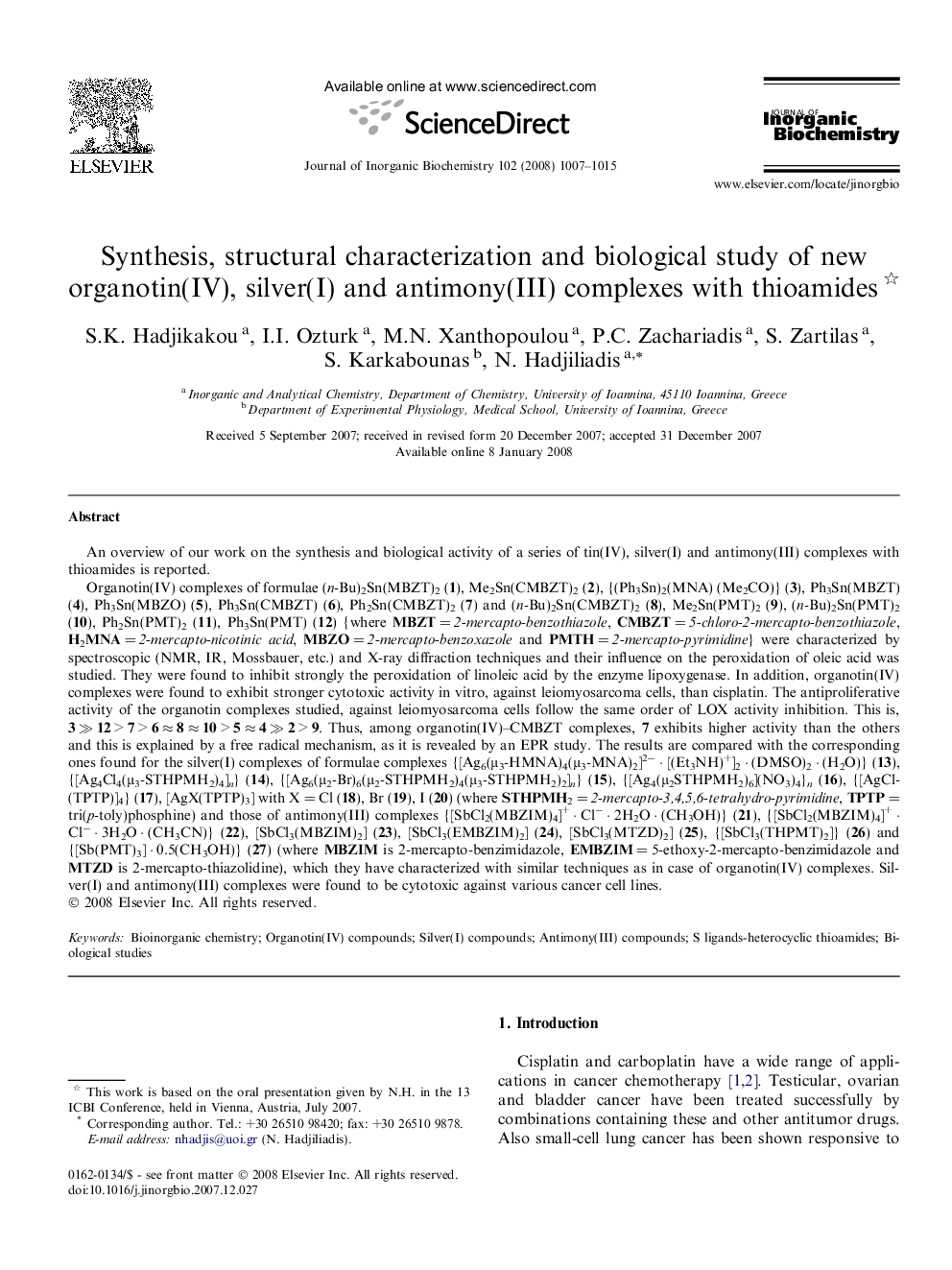| کد مقاله | کد نشریه | سال انتشار | مقاله انگلیسی | نسخه تمام متن |
|---|---|---|---|---|
| 1316575 | 1499480 | 2008 | 9 صفحه PDF | دانلود رایگان |

An overview of our work on the synthesis and biological activity of a series of tin(IV), silver(I) and antimony(III) complexes with thioamides is reported.Organotin(IV) complexes of formulae (n-Bu)2Sn(MBZT)2 (1), Me2Sn(CMBZT)2 (2), {(Ph3Sn)2(MNA) (Me2CO)} (3), Ph3Sn(MBZT) (4), Ph3Sn(MBZO) (5), Ph3Sn(CMBZT) (6), Ph2Sn(CMBZT)2 (7) and (n-Bu)2Sn(CMBZT)2 (8), Me2Sn(PMT)2 (9), (n-Bu)2Sn(PMT)2 (10), Ph2Sn(PMT)2 (11), Ph3Sn(PMT) (12) {where MBZT = 2-mercapto-benzothiazole, CMBZT = 5-chloro-2-mercapto-benzothiazole, H2MNA = 2-mercapto-nicotinic acid, MBZO = 2-mercapto-benzoxazole and PMTH = 2-mercapto-pyrimidine} were characterized by spectroscopic (NMR, IR, Mossbauer, etc.) and X-ray diffraction techniques and their influence on the peroxidation of oleic acid was studied. They were found to inhibit strongly the peroxidation of linoleic acid by the enzyme lipoxygenase. In addition, organotin(IV) complexes were found to exhibit stronger cytotoxic activity in vitro, against leiomyosarcoma cells, than cisplatin. The antiproliferative activity of the organotin complexes studied, against leiomyosarcoma cells follow the same order of LOX activity inhibition. This is, 3 ≫ 12 > 7 > 6 ≈ 8 ≈ 10 > 5 ≈ 4 ≫ 2 > 9. Thus, among organotin(IV)–CMBZT complexes, 7 exhibits higher activity than the others and this is explained by a free radical mechanism, as it is revealed by an EPR study. The results are compared with the corresponding ones found for the silver(I) complexes of formulae complexes {[Ag6(μ3-HMNA)4(μ3-MNA)2]2− · [(Et3NH)+]2 · (DMSO)2 · (H2O)} (13), {[Ag4Cl4(μ3-STHPMH2)4]n} (14), {[Ag6(μ2-Br)6(μ2-STHPMH2)4(μ3-STHPMH2)2]n} (15), {[Ag4(μ2STHPMH2)6](NO3)4}n (16), {[AgCl(TPTP)]4} (17), [AgX(TPTP)3] with X = Cl (18), Br (19), I (20) (where STHPMH2 = 2-mercapto-3,4,5,6-tetrahydro-pyrimidine, TPTP = tri(p-toly)phosphine) and those of antimony(III) complexes {[SbCl2(MBZIM)4]+ · Cl− · 2H2O · (CH3OH)} (21), {[SbCl2(MBZIM)4]+ · Cl− · 3H2O · (CH3CN)} (22), [SbCl3(MBZIM)2] (23), [SbCl3(EMBZIM)2] (24), [SbCl3(MTZD)2] (25), {[SbCl3(THPMT)2]} (26) and {[Sb(PMT)3] · 0.5(CH3OH)} (27) (where MBZIM is 2-mercapto-benzimidazole, EMBZIM = 5-ethoxy-2-mercapto-benzimidazole and MTZD is 2-mercapto-thiazolidine), which they have characterized with similar techniques as in case of organotin(IV) complexes. Silver(I) and antimony(III) complexes were found to be cytotoxic against various cancer cell lines.
Journal: Journal of Inorganic Biochemistry - Volume 102, Issues 5–6, May 2008, Pages 1007–1015